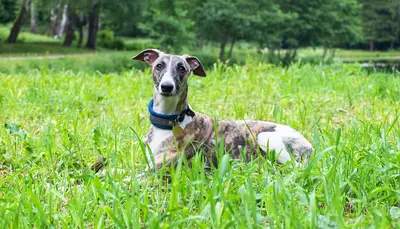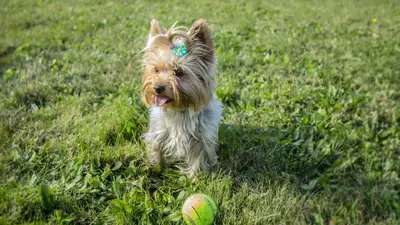Best Dog Breeds for Families
- 21 Sep 2023
- 6m read
.jpeg)
Pet parenthood starts with choosing the perfect furry friend to join your family circle—a companion that shares your joy, guards your home, and warms your heart.
From temperaments that mirror your own values to the best breeds for family protection, we'll explore it all. Discover the art of training your furry friend to be the perfect playmate for your children, and learn how to strike the right balance between nurturing a loving bond and ensuring safety.
What is the Best Family Dog?
Choosing the best family dog is not a one-size-fits-all decision. Different families have different needs, lifestyles, and preferences.
However, there are certain characteristics that make some dog breeds stand out as excellent family companions.
Here are a few factors to consider:
Temperament
A family dog should have a friendly, patient, and gentle temperament. They should be able to tolerate the unpredictable behaviour of children, including loud noises and sudden movements.
Size
The size of the dog matters. Smaller breeds are often more suitable for families with limited space, while larger breeds can be great for active families with plenty of room to roam.
Energy level
Consider your family's activity level. Some dogs are more energetic and require regular exercise, while others are content with moderate activity.
Trainability
The best family dogs are usually easy to train and eager to please. This makes it easier to teach them good manners and basic commands.
Allergies
If anyone in your family has allergies, you may want to consider hypoallergenic dog breeds that produce fewer allergens.
Which Dog Breed Will Suit My Family?
Now, let's take a look at some dog breeds that are often considered ideal for families.
Golden Retrievers
Golden Retrievers are known for their friendly and gentle nature. They are great with children, highly trainable, and often excel in obedience training.
Labrador Retrievers
Labs are one of the most popular family dog breeds. They are friendly, outgoing, and good-natured. Their enthusiasm for life is contagious.
Beagles
Beagles are small to medium-sized dogs with a loving disposition. They are great with kids and have a curious, playful nature.
Bulldogs
Bulldogs may not be the most active dogs, but they are known for their loyalty and love for their families. They are also well-suited for apartment living.
Collies
Collies are intelligent and protective, making them excellent family dogs. They are often portrayed as loyal companions in popular culture.
Cocker Spaniels
Cocker Spaniels are fantastic with kids, adaptable to different homes, and love playtime. Their trainability and loyalty make them perfect for families of all sizes. Their versatility suits various activities, and their low grooming needs are ideal for busy households.
Best Dogs for Family Protection
While most families primarily seek a loving companion in their family dog, some also value protection and security. If you're looking for a dog that can serve as both a family pet and a protector, there are breeds that excel in this role.
Keep in mind that training plays a crucial part in ensuring that your protective dog behaves appropriately around your family.
German Shepherds
German Shepherds are renowned for their intelligence and protective instincts. With proper training, they can be loyal family protectors.
Rottweiler
Rottweilers are powerful and confident dogs. When well-trained, they can be gentle with their family and fiercely protective when needed.
Doberman Pinschers
Dobermans are alert and fearless. They are known for their loyalty and can be excellent protectors while still being loving family members.
Bullmastiffs
Bullmastiffs are gentle giants that are naturally protective of their families. They are calm and affectionate with their loved ones.
Boxers
Boxers, in addition to their playful nature, have a protective streak. They can be both fun-loving companions and formidable protectors.
Remember that even protective breeds need socialisation and training to ensure they are well-behaved around your family. It's essential to strike a balance between protection and a loving family dynamic.
How Do I Train My Dog to Behave Around Children?
Training your dog to behave around children is a crucial step in ensuring a safe and harmonious family environment. Whether you have a puppy or an adult dog, here are some tips to help you with this important task:
Early socialisation
Start socialising your dog with children as early as possible. Positive interactions during puppyhood can set the tone for their behaviour around kids.
Positive reinforcement
Use positive reinforcement techniques such as treats and praise to reward good behaviour. When your dog behaves well around children, let them know they're doing a great job.
Teach basic commands
Basic commands like "sit," "stay," and "leave it" are essential for controlling your dog's behaviour around children. Enrol in obedience classes if needed.
Supervise interactions
Always supervise interactions between your dog and children, especially in the beginning. This allows you to intervene if needed and ensures safety for everyone.
Set boundaries
Teach your children how to interact with the dog respectfully. They should understand the importance of not bothering the dog when it's eating or sleeping.
Consistency
Be consistent with your training methods and rules. Dogs thrive on routine and clear expectations.
Patience: Training takes time, so be patient with your dog. They may make mistakes, but consistent training will lead to improvement.
Should Children Be Left Alone With Dogs?
While a well-trained and gentle dog can be a fantastic companion for your children, it's essential to exercise caution. Leaving children alone with dogs, regardless of the breed, should be approached with care. Here are some guidelines to consider:
Age and maturity
Consider the age and maturity of both the child and the dog. Young children may not understand how to interact safely with a dog, and some dogs may not have the patience for very young children.
Supervision
Always supervise interactions between children and dogs, especially if they are still getting to know each other. This includes playtime and feeding.
Teach respect
Teach your children to respect the dog's space and boundaries. They should understand when it's appropriate to approach the dog and when to give it space.
Reading body language
Teach your children to recognize signs of discomfort or stress in the dog, such as growling, snapping, or stiff body posture. If they see these signs, they should know to back away.
No rough play
Discourage rough play between children and dogs. Tugging on ears or tails or climbing on the dog can lead to unintended accidents.
Safe spaces
Ensure that your dog has a safe space to retreat to when they need a break from interaction. This can be a crate or a designated area.




